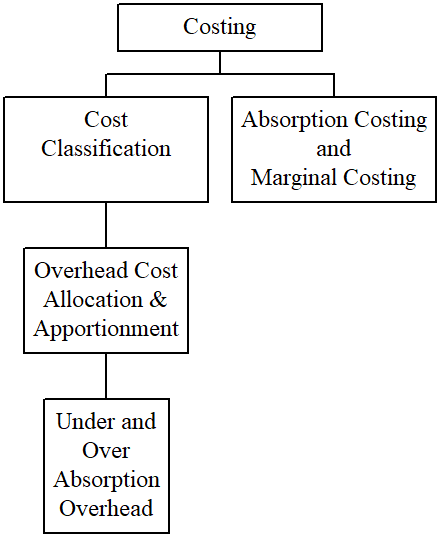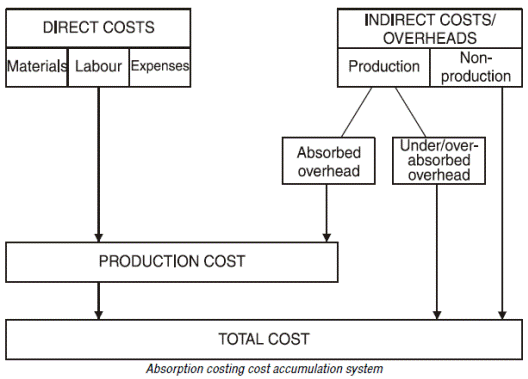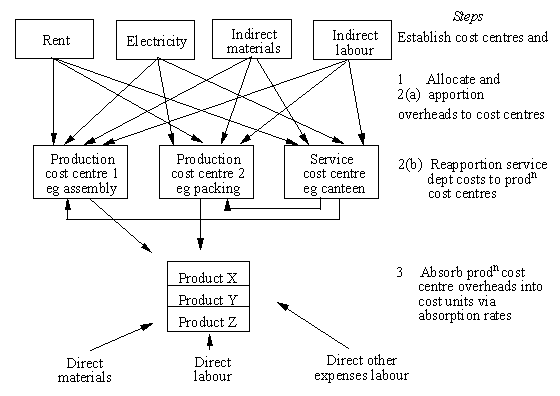Chapter 1 Costing
LEARNING OBJECTIVES 1. Explain the general concepts of costs. |

1. Introduction
1.1 Costing is the process of determining the costs of products, services or activities.
1.2 Cost accounting is used to determine the cost of products, jobs or services. Such costs have to be built up using a process known as cost accumulation.

2. Overheads => indirect
2.1 Meanings of overhead
2.1.1 If a company manufactures a product, the cost of the product will include the cost of the raw materials and components used in it and cost of the labour effort required to make it. These are direct costs of the product. The company would, however, incur many other costs in making the product, which are not directly attributable to a single product, but which are incurred generally in the process of manufacturing a large number of product units. These are indirect costs or overheads. Such costs include the following, for example:
(a) Factory rent and rates;
(b) Supervision costs;
(c) Machine depreciation;
(d) Heating and lighting, etc.
2.1.2 |
Key Terms |
|
(a) A direct cost is a cost that can be traced in full to the product, service or department that is being costed. |
2.2 Overhead cost allocation and apportionment
(Jun 15)
2.2.1 This section we focus in more detail on the two-stage overhead process of assigning overhead to products. The procedure is as follows:
(a) Assign all factory overheads to production and service cost centres.
(b) Reallocate service centre costs to production cost centres.
(c) Calculate separate overhead rates for each cost centre.
(d) Assign cost centre overhead to products.
Items (a) and (b) comprise stage one while (c) and (d) relate to stage two of the overhead assignment procedure.

2.2.2 Also, the item (a) is called the primary apportionment which is the distribution of overheads basing on the data from source documents, such as utilities bills, to respective cost centers. The item (b) is called the secondary apportionment which is the further re-distribution of overhead costs from service cost centres to the production costs centres. Costs of goods manufactured can then be calculated basing on the overhead costs per unit after secondary apportionment.
Example 1 |
|||||||||||||||||||||||||||||||||||||||||||||||||||||||||||||||||||||||||||||||||||||||||||||||||||||||||
A company is preparing its production overhead budgets and determining the apportionment of those overheads to products. Cost centre expenses and related information have been budgeted as follows.
Required: Using the direct apportionment to production department method and bases of apportionment which you consider most appropriate from the information provided, calculate overhead totals for the three production departments. |
Solution:
|
2.2.3 The choice of an absorption basis is a matter of judgement and common sense. There are no strict rules or formulae involved. But the basis should realistically reflect the characteristics of a given cost centre, avoid undue anomalies and be fair.
2.3 Over and under absorption of overheads
2.3.1 |
Over- or Under-absorbed Overhead |
|
(a) Over-/under-absorbed overhead occurs when overheads incurred do not equal overheads absorbed. |
2.3.2 The rate of overhead absorption is based on estimates (of both numerator and denominator) and it is quite likely that either one or both of the estimates will not agree with what actually occurs.
Example 2 |
||||||||
Suppose that the budgeted overhead in a production department is $80,000 and the budgeted activity is 40,000 direct labour hours, the overhead recovery rate (using a direct labour hour basis) would be $2 per direct labour hour. Actual overheads in the period are, say $84,000 and 45,000 direct labour hours are worked.
In this example, the cost of production has been charged with $6,000 more than was actually spent and so the cost that is recorded will be too high. The over-absorbed overhead will be an adjustment to the profit and loss account at the end of accounting period to reconcile the overheads charged to the actual overhead. |
Question 1 |
||||||||||||
The total production overhead expenditure of the company in Example 1 was $176,533 and its actual activity was as follows.
Required: Using the information above and the results of Example 1, calculate the under- or over-absorption of overheads. |
2.3.3 The overhead absorption rate is predetermined from budget estimates of overhead cost and activity level. Under or over recovery of overhead will occur in the following circumstances.
(a) Actual overhead costs are different from budgeted overheads.
(b) The actual activity level is different from the budgeted activity level.
(c) Actual overhead costs and actual activity level differ from those budgeted.
Question 2 There are five hotels in a hotel chain and their particulars are as follows:
There are two corporate positions who oversee the operations of these hotels; they are director of operations and corporate sales director. The annual salaries of these two positions are HK$2,000,000 and HK$1,500,000 respectively. Required: (a) If the total salaries of these directors are shared equally among the five hotels, how much is the cost allocated to each hotel? Assume the two administrative positions are fixed overheads from the hotel chain’s perspective. (3 marks) |
3. Absorption Costing and Marginal Costing
3.1 |
Key Terms |
|
(a) Absorption costing (full costing) is a form of costing in which the costs of products are calculated by adding an amount for indirect costs (overheads) to the direct costs of production. => Fixed Overheads |
Example 3 |
A company makes and sells a single product. At the beginning of period 1, there are no opening inventories of the product, for which the variable production cost is $4 and the sales price $6 per unit. Fixed costs are $2,000 per period, of which $1,500 are fixed production costs. Normal production is 1,500 units per period. In period 1, sales were 1,200 units, production was 1,500 units. In period 2, sales were 1,700 units, production was 1,400 units. Required: (a) Prepare profit statements for each period and for the two periods in total using both absorption costing and marginal costing. |
Solution:
Marginal costing
(b)
|
||||||||||||||||||||||||||||||||||||||||||||||||||||||||||||||||||||||||||||||||||||||||||||||||||||||||||||||||||||||||||||||||||||||||||||||||||||||||||||||||||||||||||||||||||||||||||||||||||||||||||||
3.2 |
Reconciliation of Profits between Two Methods |
|
(a) If opening inventory = closing inventory, MC profit = AC profit |
Question 3 – Manipulating Profits |
ABC Co budgeted to make and sell 10,000 units of its product in 2011. The selling price is $10 per unit and the variable cost $4 per unit. Fixed production costs were budgeted at $50,000 per year. The company uses absorption costing and budgeted an absorption rate of $5 per unit. During 2011, it became apparent that sales demand would only be 8,000 units. The management, concerned about the apparent effect of the low volume of sales on profits, decided to increase production for the year to 15,000 units. Actual fixed costs were still expected to be $50,000 in spite of the significant increase in production volume. Required: Calculate the profit at an actual sales volume of 8,000 units, using the following methods. |
Source: https://hkiaatevening.yolasite.com/resources/PBEP2Notes/Ch1-Costing.doc
Web site to visit: https://hkiaatevening.yolasite.com
Author of the text: indicated on the source document of the above text
If you are the author of the text above and you not agree to share your knowledge for teaching, research, scholarship (for fair use as indicated in the United States copyrigh low) please send us an e-mail and we will remove your text quickly. Fair use is a limitation and exception to the exclusive right granted by copyright law to the author of a creative work. In United States copyright law, fair use is a doctrine that permits limited use of copyrighted material without acquiring permission from the rights holders. Examples of fair use include commentary, search engines, criticism, news reporting, research, teaching, library archiving and scholarship. It provides for the legal, unlicensed citation or incorporation of copyrighted material in another author's work under a four-factor balancing test. (source: http://en.wikipedia.org/wiki/Fair_use)
The information of medicine and health contained in the site are of a general nature and purpose which is purely informative and for this reason may not replace in any case, the council of a doctor or a qualified entity legally to the profession.
The texts are the property of their respective authors and we thank them for giving us the opportunity to share for free to students, teachers and users of the Web their texts will used only for illustrative educational and scientific purposes only.
All the information in our site are given for nonprofit educational purposes